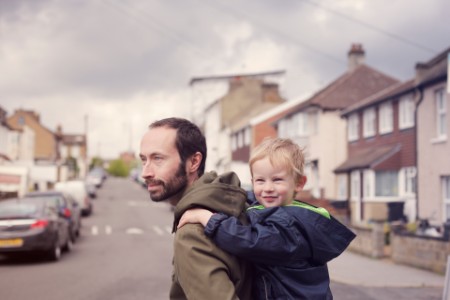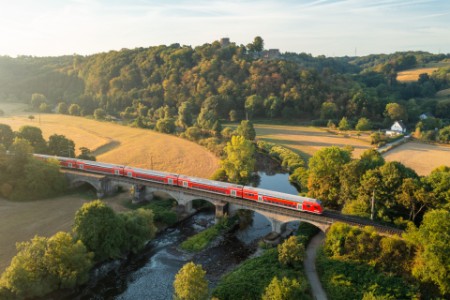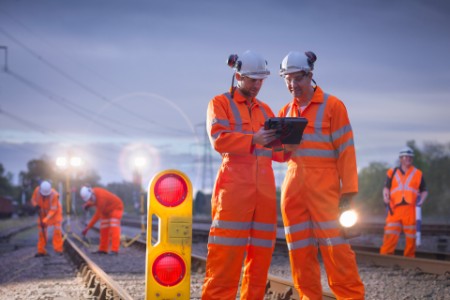How can digital transformation help rewrite real-world safety?
Network Rail is responsible for running a safe, reliable and efficient railway across Great Britain. Safety is at the heart of everything it does, not least for its employees and contractors. Unfortunately, it is not always possible to close entire sections of the line whilst repairs or essential maintenance tasks are being carried out, leaving workers vulnerable to the operational risks of a live railway; tragically, 33 employees and contractors have been killed on Network Rail infrastructure since 2008. Despite significant investment from Network Rail, two previous attempts to invigorate its track worker safety programmes had failed, leaving employees feeling sceptical that the organisation could ever get railway safety right.
In 2019, Network Rail launched an ambitious Safety Task Force programme to completely overhaul its safety procedures, some of which still relied on paper-based documentation. In particular, a Safe Work Pack (SWP) that had traditionally been required for each project planned to be carried out on or near the tracks could contain as many as 60 A4 pages. SWPs normally includes the full details of the work involved, the specific risks associated with the site, details of which lines will be closed to accommodate the work and for how long, what to do in an emergency and much more.
However, the organisation’s historic reliance on paper-based information was causing several problems for staff, including inaccurate paper trails that led to unnecessary works being carried out by frontline workers, creating potentially dangerous situations. The environmental burden created by the use of so much paper was another issue that needed addressing.
Network Rail leaders knew that a data-driven technology solution could help them to achieve a number of their key railway safety goals. They had been working with the EY organisation for nearly 10 years, and so they looked to EY teams for support to develop and implement this safety innovation.
EY teams needed to understand how to deliver not just a digital transformation, but also a business transformation that would change employee behaviours around railway safety throughout the organisation.

Implementing tech-enabled cultural change
Placing the technology users at the heart of the safety innovation programme, EY teams consulted senior stakeholders and representatives from the population of 22,000 people across Network Rail and its supply chain who would be using the system. They gathered views not just on how the new system should function, but also on the preferred methods of engaging, training and supporting users.
By engaging with these teams directly, not only were EY teams able to identify areas for improvement in Network Rail safety procedures, but they also got a clearer picture of how these stakeholders would prefer to be upskilled in a new technology. By doing so, they were able to diminish scepticism and collaborate with rail workers in a meaningful way; the changes were not being imposed upon them. Instead, frontline workers were an essential voice driving the digital transformation strategy, working jointly with EY consultants to co-create an approach that would be adopted by the stakeholder network.
Large-scale onboarding
22,000end users onboarded across Network Rail and its supply chain
Following significant consultation, the result was a new digital safety platform called Network Rail–RailHub, accompanied by an iOS application with offline capability so that workers can use it in remote locations. Network Rail–RailHub empowers users to identify, understand and mitigate railway safety risks, book access to the track to carry out work and capture the progress of their work and lessons learned. It provides a single source of truth for everyone working on or near the railway line.
Sean Meade, Partner, Technology Consulting, Ernst & Young LLP, explains that the project involved a wide range of personnel from the EY organisation and beyond. “We brought together several capabilities from across our Consulting practice to provide Network Rail with the right people to deliver a connected, innovative and holistic solution at pace,” he says. This included people from Technology Consulting, Business Consulting, People Consulting, EY Seren and Global Delivery Services. “By bringing together these diverse teams from across our business, we were able to meet the challenge in a holistic way and approach the problem from every angle, considering the business problem in concert with the very real human element. We also worked alongside industry-leading partners in our ecosystem, including Arup, Capgemini, Egis, Morson and OnTrac, to leverage the expertise our client needed,” he adds.
Driving behavioural change
In a devolved business, an innovative approach to technology deployment was essential. The EY team focussed on giving each of Network Rail’s 13 routes ownership and accountability for their own deployment; they worked closely with each route to execute a detailed business readiness plan to make the necessary people, process and technology preparations in advance of the safety transformation.
To gain buy-in and support for Network Rail–RailHub, the team met with end users around the UK at roadshow events, upskilled ‘super users’ on the system in advance of cutover and maintained a two-way dialogue with stakeholders at all levels across the business.
To drive behavioural and cultural change, people need to believe in the mission, but they also need to believe that they’re part of it.
The EY team took a persona-based approach to communications; after conducting extensive interviews and focus groups, they communicated with different user groups based on their persona profiles, tailoring key messages based on their needs and preferences.
Due to the widely dispersed nature of Network Rail’s workforce, the EY team and its partners designed a human-centred training strategy, upskilling users in local depots across the UK. More than 12,000 hours of training were delivered in more than 150 locations. In almost all cases, users were trained in their local workplace, at a time that suited their schedule; training was delivered during both days and nights, to cater to the needs of night shift workers as well.
In the lead-up to cutover, users were given access to a dedicated hotline which offered practical support on the Network Rail–RailHub system. In-person support was also available in the post go-live period, with trained personnel deployed to local depots to support the launch of the safety innovation programme. A dedicated microsite and mailbox were made available to users, ensuring all the information they needed was available.
User training
12,000hours of training delivered on Network Rail–RailHub
“One of the successes of this digital transformation programme is that we took our end users and the business on the journey with us,” says Dylan Edwards, Senior Programme Manager, Network Rail. “To drive behavioural and cultural change, people need to believe in the mission, but they also need to believe that they’re part of it.”
Harj Athwal, Senior Manager, Technology Consulting, Ernst & Young LLP, adds: “The most important thing was to remind people why we were there, which was ‘everyone home safe, every day’. In every workshop, whether we were gathering the requirements or explaining the solution design, it was always framed in that context, so that all the team members understood that was the ultimate purpose.”
Throughout the deployment for each route, the EY team’s focus was to ensure that the approach taken was tailored to Network Rail’s established ways of working and did not interrupt the normal and safe operation of the railway. This human-centred and adaptive approach allowed the team to win the support of users, enabling adoption of the software and fundamentally driving a cultural shift towards safer working practices.
“This has set a gold standard for transitions to a new system in Network Rail – both from a technology cutover perspective and supporting our user community to use Network Rail–RailHub – with minimal disruption to our business operations,” comments Edwards.

Transformation with sustainable benefits
The introduction of Network Rail–RailHub brought numerous safety benefits. The system has increased compliance with Standard 019, the key railway safety performance benchmark for those working on or near the line that Network Rail is measured against. Network Rail–RailHub enables it to deliver on its promise to reduce accident rates and address operational risks whilst, significantly, helping to change the organisation’s safety behaviour and culture by ensuring work is carried out systematically following the correct safety procedures. Since the introduction of Network Rail–RailHub, there has been an 18% reduction in safety-critical errors in SWPs and a 43% reduction in near-miss incidents.
Safety improvements
18%reduction in safety-critical errors since the introduction of Network Rail–RailHub
The transition from legacy systems to a single, integrated, cloud-based system has improved efficiency substantially; users no longer have to switch between systems to complete their work, and source data is pre-populated in Network Rail–RailHub. This includes visibility of slots to deliver work, resulting in a 40% reduction in errors on line blockage applications – a key metric for Network Rail.
The organisation has also realised substantial sustainability benefits through the transition from paper-based working to a fully digital system; an estimated 34 million sheets of paper are now being saved every year. In addition, track workers no longer have to travel back to site to submit their paperwork at the end of a shift, as this process is completed through the touch of a button – representing additional financial and environmental benefits.
Sustainability gains
34 millionestimated number of sheets of paper saved every year by using Network Rail–RailHub
Operational improvements
The development and implementation of Network Rail–RailHub has also enabled a number of current and future enhancements to Network Rail’s operations.
One immediate benefit was an improvement in data quality across Network Rail, where this had not previously been the highest priority. To give users visibility of various datasets in a single interface, Network Rail–RailHub pulls in data from 10 existing systems and the process of consolidating and standardising this information necessitated improvements in data gathering and accuracy.
The launch of Network Rail–RailHub has also helped to drive effective conversations about safety. Senior Network Rail managers now have access to a management information dashboard which takes data from Network Rail–RailHub. They can see trends in areas such as when SWPs are verified, how many are being created and what additional protection is being used, for example.
This will facilitate important conversations around safety. Our previous systems were not set up for reporting, so senior management would not have sight of that kind of data.
“This will facilitate important conversations around safety,” says Toby Keates, Programme Manager for Network Rail–RailHub. “Our previous systems were not set up for reporting, so senior management would not have sight of that kind of data or the specifics. For example, if there was an accident or a near miss, they wouldn’t necessarily know which team was there. There’s much more transparency now.”
By placing Network Rail’s workforce at the heart of the tech-enabled transformation, the EY team was able to ensure Network Rail successfully achieved their objectives for Network Rail–RailHub, ultimately getting everyone home safe, every day.



